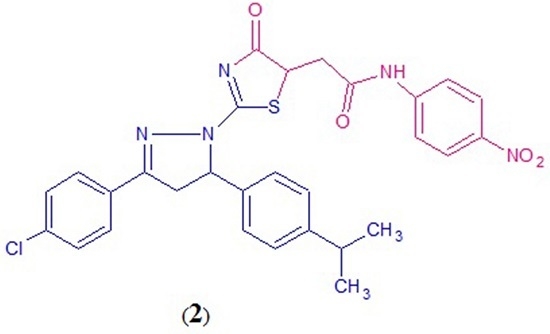N-(4-Nitrophenyl)-2-{2-[3-(4-chlorophenyl)-5-[4-(propan-2-yl)phenyl]-4,5-dihydro-1H-pyrazol-1-yl]-4-oxo-4,5-dihydro-1,3-thiazol-5-yl}acetamide
Abstract
:1. Introduction
2. Results
3. Discussion
4. Materials and Methods
5. Conclusions
Supplementary Materials
Acknowledgments
Author Contributions
Conflicts of Interest
References
- Patel, N.; Bux, F.B.; Parmar, V.; Singh, A. Synthesis and biological studies of novel thiazolidinones. Rasayan J. Chem. 2011, 4, 790–794. [Google Scholar]
- Gursoy, A.; Terzioglu, N. Synthesis and isolation of new regioisomeric 4-thiazolidinones and their anticonvulsant activity. Turk. J. Chem. 2005, 29, 247–254. [Google Scholar]
- Barreca, M.L.; Chimirri, A.; De Luca, L.; Monforte, A.M.; Monforte, P.; Rao, A.; Zappala, M.; Balzarini, J.; De Clercq, E.; Pannecouque, C.; et al. Discovery of 2,3-diaryl-1,3-thiazolidin-4-ones as potent anti-HIV-1 agents. Bioorg. Med. Chem. Lett. 2001, 11, 1793–1796. [Google Scholar] [CrossRef]
- Carbone, A. Synthesis and anti-HIV activity of 2,3-diaryl-1,3-thiazolidin-4-(thi)one derivatives. Il Pharmaco 2002, 57, 747–751. [Google Scholar]
- Kumar, A.; Rajput, C.S.; Bhati, S.K. Synthesis of 3-[4′-(p-chlorophenyl)-thiazol-2'-yl]-2-[(substituted azetidinone/thiazolidinone)-aminomethyl]-6-bromoquinazolin-4-ones as anti-inflammatory agents. Bioorg. Med. Chem. 2007, 15, 3089–3096. [Google Scholar] [CrossRef] [PubMed]
- Li, W.; Wang, Z.; Gududuru, V.; Zbytek, B.; Slominski, A.T.; Dalton, J.T.; Miller, D.D. Structure activity relationship studies of arylthiazolidine amides as selective cytotoxic agents for melanoma. Anticancer Res. 2007, 27, 883–888. [Google Scholar] [PubMed]
- Babaoglu, K.; Page, M.A.; Jones, V.C.; McNeil, M.R.; Dong, C.; Naismith, J.H.; Lee, R.E. Novel inhibitors of an emerging target in Mycobacterium tuberculosis; substituted thiazolidinones as inhibitors of dTDP-rhamnose synthesis. Bioorg. Med. Chem. Lett. 2003, 13, 3227–3230. [Google Scholar] [CrossRef]
- Ilango, K.; Arunkumar, S. Synthesis and antitubercular activity of novel 2-aryl N-(3,4,5-trihydroxy benzamido)-4-thiazolidinone derivatives. Rasayan J. Chem. 2010, 3, 493–496. [Google Scholar]
- Geronikaki, A.A.; Pitta, E.P.; Liaras, K.S. Thiazoles and thiazolidinones as antioxidants. Curr. Med. Chem. 2013, 20, 4460–4480. [Google Scholar] [CrossRef] [PubMed]
- Vigorita, M.G.; Previtera, T.; Basile, M.; Fenech, G.; Pasquale, R.C.; Occhiuto, F.; Circosta, C. 3,3'-Di[1,3-thiazolidine-4-one]system. IV. Synthesis and pharmacological properties of 3,3(1,2-ethanediyl)bis [2-aryl-1,3-thiazolidine-4-one 1,1-dioxide] derivatives. Farmaco Sci. 1988, 43, 373–379. [Google Scholar] [PubMed]
- Ravichandran, V.; Jain, A.; Kumar, K.S.; Rajak, H.; Agarwal, R.K. Design, synthesis, and evaluation of thiazolidinone derivatives as antimicrobial and antiviral agents. Chem. Biol. Drug Des. 2011, 78, 464–470. [Google Scholar] [CrossRef] [PubMed]
- Murugan, R.; Anbazhagan, S.; Narayanan, S.S. Synthesis and in vivo antidiabetic activity of novel dispiropyrrolidines through [3+2] cycloaddition reactions with thiazolidinedione and rhodanine derivatives. Eur. J. Med. Chem. 2009, 44, 3272–3279. [Google Scholar] [CrossRef] [PubMed]
- Marrian, D.H. The condensation of N-substituted maleimides with thioureas. J. Chem. Soc. 1949, 384, 1797–1799. [Google Scholar] [CrossRef]
- Pankova, A.S.; Golubev, P.R.; Khlebnikov, A.F.; Yulvanov, A.; Kuznetsov, M.A. Thiazol-4-one derivatives from the reaction of monosubstituted thioureas with maleimides: Structures and factors determining the selectivity and tautomeric equilibrium in solution. Beilstein J. Org. Chem. 2016, 12, 2563–2569. [Google Scholar] [CrossRef] [PubMed]
- Narayana, B.; Salian, V.V.; Sarojini, B.K.; Jasinski, J.P. (2E)-1-(4-Chlorophenyl)-3-[4-(propan-2-yl)phenyl]prop-2-en-1-one. Acta Cryst. 2014, E70, o855. [Google Scholar] [CrossRef] [PubMed]
- Salian, V.V.; Narayana, B.; Sarojini, B.K.; Sindhupriya, E.S.; Madhu, L.N.; Rao, S. Biologically potent pyrazoline derivatives from versatile (2)-1-(4-chlorophenyl)-3-[4-(propan-2-yl)phenyl]prop-2-en-1-one. Lett. Drug Des. Discov. 2017, 14, 216–227. [Google Scholar] [CrossRef]
- Salian, V.V.; Narayana, B.; Sarojini, B.K.; Kumar, M.S.; Nagananda, G.S.; Byrappa, K.; Kudva, A.K. Spectroscopic, single crystal X-ray, Hirshfeld, in vitro and in silico biological evaluation of a new series of potent thiazole nucleus integrated with pyrazoline scaffolds. Spectrochim. Acta A Mol. Biomol. 2017, 174, 254–271. [Google Scholar] [CrossRef] [PubMed]

© 2017 by the authors. Licensee MDPI, Basel, Switzerland. This article is an open access article distributed under the terms and conditions of the Creative Commons Attribution (CC BY) license (http://creativecommons.org/licenses/by/4.0/).
Share and Cite
Salian, V.V.; Narayana, B.; Sarojini, B.K. N-(4-Nitrophenyl)-2-{2-[3-(4-chlorophenyl)-5-[4-(propan-2-yl)phenyl]-4,5-dihydro-1H-pyrazol-1-yl]-4-oxo-4,5-dihydro-1,3-thiazol-5-yl}acetamide. Molbank 2017, 2017, M943. https://doi.org/10.3390/M943
Salian VV, Narayana B, Sarojini BK. N-(4-Nitrophenyl)-2-{2-[3-(4-chlorophenyl)-5-[4-(propan-2-yl)phenyl]-4,5-dihydro-1H-pyrazol-1-yl]-4-oxo-4,5-dihydro-1,3-thiazol-5-yl}acetamide. Molbank. 2017; 2017(2):M943. https://doi.org/10.3390/M943
Chicago/Turabian StyleSalian, Vinutha V., Badiadka Narayana, and Balladka K. Sarojini. 2017. "N-(4-Nitrophenyl)-2-{2-[3-(4-chlorophenyl)-5-[4-(propan-2-yl)phenyl]-4,5-dihydro-1H-pyrazol-1-yl]-4-oxo-4,5-dihydro-1,3-thiazol-5-yl}acetamide" Molbank 2017, no. 2: M943. https://doi.org/10.3390/M943
APA StyleSalian, V. V., Narayana, B., & Sarojini, B. K. (2017). N-(4-Nitrophenyl)-2-{2-[3-(4-chlorophenyl)-5-[4-(propan-2-yl)phenyl]-4,5-dihydro-1H-pyrazol-1-yl]-4-oxo-4,5-dihydro-1,3-thiazol-5-yl}acetamide. Molbank, 2017(2), M943. https://doi.org/10.3390/M943





